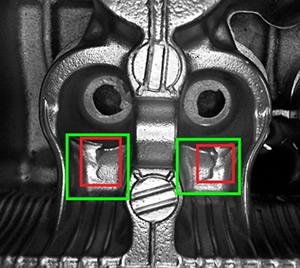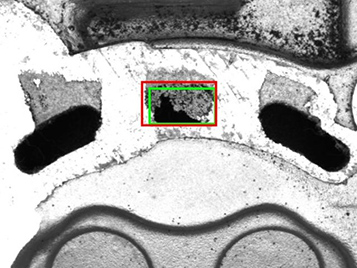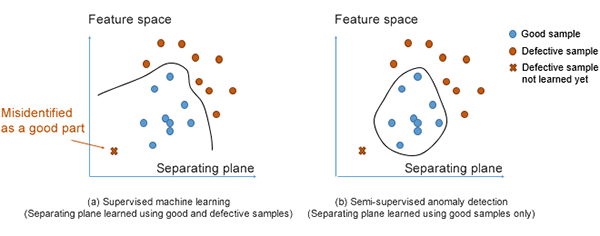- Home
- Ricoh's Technology
- Image Recognition and Analysis Technology for Visual Inspection
Image Recognition and Analysis Technology for Visual Inspection
Artificial intelligence (AI), in which a machine itself learns, has been an area of active research and development recently.
By applying machine learning, Ricoh has developed image recognition and analysis technology which allows accurate detection of anomalies even when the number of sample images is small. Opportunities for this technology are particularly high for industrial applications.
The program using this technology received an award for excellence for the second consecutive year (in 2014 and 2015) at Visual Inspection Algorithm held in Japan, a competition of precisely detecting product defects.
Needs for automatic visual inspection in the manufacturing area
At manufacturing facilities, there is a need to classify the manufactured parts as good or defective through automatic visual inspection based on images.
In general, there are more good parts than defective parts among those manufactured. Thus, it is difficult to prepare a large number of defective samples. Further, preparation is even more difficult if there are many types of defects, because many different samples must be prepared to cover all types of defects.
Detect unknown types of defects, by learning data on only good parts
Ricoh chose to use semi-supervised anomaly detection as the machine learning method, and worked on the feature quantities used for the machine learning so that learning is possible even when the number of samples is small. In an algorithm using semi-supervised anomaly detection, system learns data on good parts only, so high identification performance can be expected even for unknown types of defects.

Figure 1 Example 1 of detection results
(Source of image:Visual Inspection Algorithm Contest 2014(Japanese only))

Figure 2 Example 2 of detection results
(Source of image:Visual Inspection Algorithm Contest 2015(Japanese only))
Figures 1 and 2 show examples of detection results using the algorithm. The red frames indicate the correct-answer areas designated manually, where defects are to be detected. The green frames indicate the areas where defects are detected according to the algorithm. The figures show that the detection areas obtained by the algorithm are similar to the correct-answer defect detection areas.
Features of semi-supervised anomaly detection, the machine learning method
Machine learning is a method used in image recognition and analysis. In machine learning, a computer receives certain inputs, learns from them, and predicts useful outputs. As a preliminary step, the system needs to have learned combinations of certain input images and corresponding correct-answer outputs (correct-answer labels). The learning step is followed by the decision step, where the system receives a certain image input and predicts and outputs the correct answer based on what it has learned.
Generally, in supervised machine learning, data of all labels (input images and corresponding correct-answer outputs) is used for the learning. To learn how to tell good parts from defective ones, for instance, the system needs to learn using a data set that contains samples of both good and defective parts (the sample images of the parts and the labels that indicate whether they are good or defective).
Semi-supervised anomaly detection is another method of machine learning. In this method, learning is based on data of a single label only, for instance, good parts only. The data of only one label needs to be prepared, so learning can be based on a limited number of samples.
In the learning step of machine learning, the system calculates feature quantities for multiple input images (correct-answer images) and learns them as correct-answer feature quantities. In the decision step, the system similarly calculates feature quantities for input images—the system then uses the calculated feature quantities and the correct-answer feature quantities it has learned in the learning step so as to predict the correct answer, and outputs the answer.
When images are converted into feature quantities, the space based on the feature quantities (feature vectors as they are multi-dimensional) is called the feature space. In the recognition process, identification is made based on machine learning in this feature space. As shown in figure 3, in the learning step, a separating plane is formed in a multi-dimensional feature space. In the decision step, identification is made on to which label the feature quantities of input image are classified.

Figure 3 Difference in learning methods in the feature space
Ricoh has developed a new algorithm that combines the semi-supervised anomaly detection with feature quantities appropriately describing the shape of a target object in an image. The algorithm was applied to an image-based visual inspection in the area of manufacturing, and high-precision recognition was confirmed.
Pursuing fusion of optics and image recognition and analysis technologies
In the industrial field, Ricoh will continue to develop and deliver not only optical module products but also such system solutions involving image recognition and analysis technologies.
Sorted by : field “Image Processing / Analysis” “AI (Artificial Intelligence)”

